
Peterscourt is a building in Peterborough, on City Road, which was designed by George Gilbert Scott and completed in 1859. It is Grade II listed. [1]

Peterscourt is a building in Peterborough, on City Road, which was designed by George Gilbert Scott and completed in 1859. It is Grade II listed. [1]
The building was designed for, and housed, St Peter's Teacher Training College for men until 1914. From 1921 to 1938 it was a teacher training college for women. During the Second World War the building housed the 'American Red Cross Club'. Between 1946 and 1950 it was a temporary college, particularly to train ex-service students. Subsequently it has been used mainly for offices, by Perkins Engines and Peterborough Development Corporation. In the early 1950s, when it housed the sales department of Perkins Engines, it was given the name 'Peterscourt'. The doorway at the side of the building was rescued from the Guildhall, London after the London Blitz and brought to Frank Perkins' offices in Peterscourt. The Peterborough Development Corporation's headquarters were here from 1969 to 1975. [2]
Restoration and refurbishment took place in 1985. [3] As of 2017 it is the home of the Eco Innovation Centre. [4] In 2023, it was being used as a serviced office centre by NPS on behalf of Peterborough City Council. [5]

The building is mainly listed for the early 18th-century doorway which was brought from the London Guildhall following damage in the Second World War. [6] [1] It has finely carved Corinthian pilasters with swags on the frieze and a rectangular fanlight with Gothick glazing. [1]

Peterborough is a cathedral city in the City of Peterborough district in the ceremonial county of Cambridgeshire, England. For centuries, the city and many of its surrounding villages formed the Soke of Peterborough, in the historic county of Northamptonshire. The Soke of Peterborough had an independent county council, based in the city, between 1889 and 1965. After the Soke of Peterborough was abolished in 1965, the city formed part of the short-lived Huntingdon and Peterborough until 1974. Though the city has a long history as part of Northamptonshire, the city has been part of Cambridgeshire since 1974, and is the largest settlement in that county.

Guildhall is a municipal building in the Moorgate area of the City of London, England. It is off Gresham and Basinghall streets, in the wards of Bassishaw and Cheap. The current building dates from the 15th century; however documentary evidence suggests that a guildhall had existed at the site since at least the early 12th century. The building has been used as a town hall for several hundred years, and is still the ceremonial and administrative centre of the City of London and its Corporation. It should not be confused with London's City Hall, the administrative centre for Greater London. The term "Guildhall" refers both to the whole building and to its main room, which is a medieval great hall. It is a Grade I-listed building.
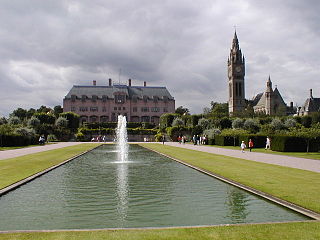
Eaton Hall is the country house of the Duke of Westminster. It is 1 mile (2 km) south of the village of Eccleston, in Cheshire, England. The house is surrounded by its own formal gardens, parkland, farmland and woodland. The estate covers about 10,872 acres (4,400 ha).

The Middlesex Guildhall is an historic court building in Westminster which houses the Supreme Court of the United Kingdom and the Judicial Committee of the Privy Council. The building stands on the south-western corner of Parliament Square, near the Palace of Westminster. In 1970, the building was listed Grade II*.

Richard Gilbert Scott was a British architect, born in London, the son of Giles Gilbert Scott and great-grandson of the great Gothic Revival architect George Gilbert Scott. He was educated at Harrow, Charterhouse School, Bartlett School of Architecture London University, and Regent Street Polytechnic School of Architecture.
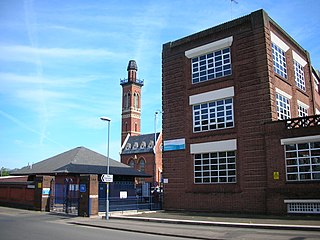
Edgbaston Waterworks lies to the east of Edgbaston Reservoir, two miles west of the centre of Birmingham, England.
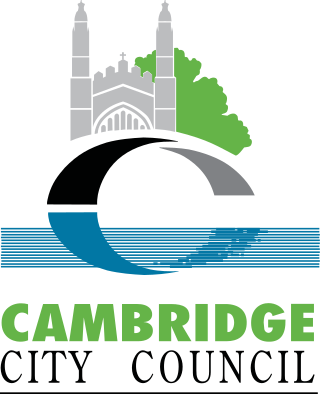
Cambridge City Council is the local authority for Cambridge, a non-metropolitan district with city status in Cambridgeshire, England. The council has been under Labour majority control since 2014. It meets at Cambridge Guildhall. The council is a member of the Cambridgeshire and Peterborough Combined Authority.
Westwood is a residential area of the city of Peterborough, in the ceremonial county of Cambridgeshire, England. For electoral purposes it forms part of Ravensthorpe ward. Manufacturers of industrial machinery, Baker Perkins, relocated here from London in 1903. HMP Peterborough, the first purpose-built prison to house both men and women, opened on the site of the former engineering works in 2005.

Bath College is a further education college in the centre of Bath, Somerset and in Westfield, Somerset, England. It was formed in April 2015 by the merger of City of Bath College and Norton Radstock College. The College also offers Higher Education courses and has its own Undergraduate building.
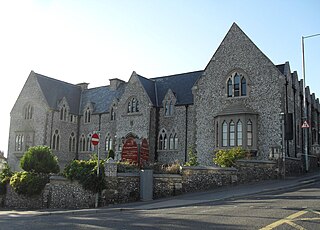
Citibase Brighton is a complex of serviced offices on a prominent elevated position in the Round Hill area of Brighton, part of the English city of Brighton and Hove. The large Gothic Revival building, by two architect brothers from London, has had three greatly different uses since its construction at the edge of Brighton parish in 1854: for its first 85 years, it trained Anglican schoolmistresses; then it became a military base and records office; and in 1988 it opened as a multipurpose business centre and office complex. The elaborate flint exterior is finely detailed in the Gothic style, especially around the windows. English Heritage has listed it at Grade II for its architectural and historical importance.
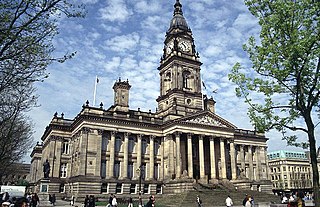
Bolton Town Hall in Victoria Square, Bolton, Greater Manchester, England, was built between 1866 and 1873 for the County Borough of Bolton to designs by William Hill of Leeds and George Woodhouse of Bolton. The town hall was extended in the 1930s to the designs of Bradshaw, Gass and Hope and has been designated a Grade II* listed building by English Heritage.

The Crescent is a street in Taunton, a town in the English county of Somerset. Construction began in 1807, during a period of extensive redevelopment in the town, driven by the Market House Society and the Member of Parliament Sir Benjamin Hammet. Lined on the eastern side by a Georgian terrace, the street follows a shallow crescent shape, broken in the middle by Crescent Way and a bit further south by St George's Place. It links Upper High Street, at its southern end, with Park Street and Tower Street to the north. On the western side, Somerset County Council have their offices in the County Hall, erected in 1935, and extended in the 1960s. The Georgian terrace, the Masonic Hall, and the County Hall are recorded in the National Heritage List for England as listed buildings.

Ernest Berry Webber, was an English architect, surveyor and town planner best known for his designs of municipal buildings, including those in Southampton in Hampshire, and Dagenham and Hammersmith, both in London.

Plymouth Civic Centre is the former headquarters of Plymouth City Council on Armada Way in Plymouth, Devon, England. The building is in two sections, comprising a 14-storey tower block which housed the council's offices, and a two-storey southern wing called the Council House which includes the council chamber and is linked to the tower block by a bridge at first floor level. The building was completed in 1962. The council sold the tower block part of the building in 2015, but the Council House remains the council's meeting place. The whole complex has been a Grade II listed building since 2007.

The Old Town Hall is a municipal building in the Market Place in Wilton, Wiltshire, England. The structure, which is currently used as a Baptist church, is a Grade II listed building.
Abbey is an electoral ward in the city of Derby, England. The ward contains 15 listed buildings that are recorded in the National Heritage List for England. Of these, one is listed at Grade II*, the middle of the three grades, and the others are at Grade II, the lowest grade. The ward, which is to the west of the city centre, is mainly residential. The listed buildings include a public house, a former toll house, private houses later used for other purposes, the lodge to a cemetery and three memorials in the cemetery, a former training college, former barracks, a church and associated structures, and an engine house and a warehouse built by the Great Northern Railway.

The Municipal Buildings are in West Street, Boston, a town in Lincolnshire, in England. The complex accommodates the offices and meeting place of Boston Borough Council.

Bodmin Guildhall is a historic building in Fore Street in Bodmin, a town in Cornwall, in England. The structure, which was used for municipal purposes before being converted for use as a baker's shop and restaurant, is a Grade II listed building.

Ludlow Guildhall is a historic building in Mill Street in Ludlow, a town in Shropshire, in England. The building, which accommodates the offices and meeting place of Ludlow Town Council, is a Grade I listed building.